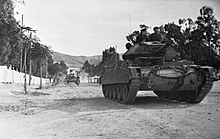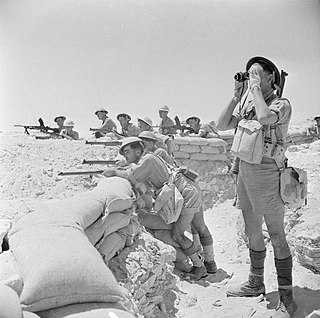
The First Battle of El Alamein was a battle of the Western Desert campaign of the Second World War, fought in Egypt between Axis forces of the Panzer Army Africa—which included the Afrika Korps under Field Marshal Erwin Rommel—and Allied forces of the Eighth Army under General Claude Auchinleck.

The Second Battle of El Alamein was a battle of the Second World War that took place near the Egyptian railway halt of El Alamein. The First Battle of El Alamein and the Battle of Alam el Halfa had prevented the Axis from advancing further into Egypt.

Edward James "Ted" Hughes was an English poet, translator, and children's writer. Critics frequently rank him as one of the best poets of his generation and one of the twentieth century's greatest writers. He was appointed Poet Laureate in 1984 and held the office until his death. In 2008, The Times ranked Hughes fourth on its list of "The 50 greatest British writers since 1945".

The 7th Armoured Division was an armoured division of the British Army. It was formed as the Mobile Division (Egypt) on 27 September 1938, after increased tensions between Britain and the Axis powers. This was part of an effort to reinforce and maintain the British strategic presence in Egypt to defend the Suez Canal, which was seen as vital to the British Empire's interests. In February 1940, the formation was renamed as the 7th Armoured Division. During its early years, the jerboa was adopted as the mascot and divisional insignia giving rise to the nickname Desert Rats.

Keith Castellain Douglas was a poet and soldier noted for his war poetry during the Second World War and his wry memoir of the Western Desert campaign, Alamein to Zem Zem. He was killed in action during the invasion of Normandy.

XXX Corps was a corps of the British Army during the Second World War. The corps was formed in the Western Desert in September 1941. It provided extensive service in the North African Campaign and many of its units were in action at the Second Battle of El Alamein in late 1942. It then took part in the Tunisia Campaign and formed the left flank during the Allied invasion of Sicily in 1943.
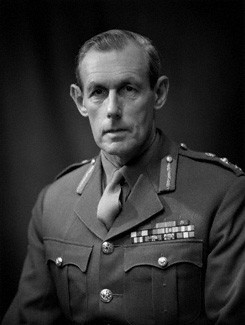
Field Marshal Richard Michael Power Carver, Baron Carver, was a senior British Army officer. Lord Carver served as the Chief of the General Staff (CGS), the professional head of the British Army, and then as the Chief of the Defence Staff (CDS), the professional head of the British Armed Forces. He served with distinction during the Second World War and organised the administration of British forces deployed in response to the Mau Mau Uprising in Kenya and later in his career provided advice to the British government on the response to the early stages of The Troubles in Northern Ireland.
Meary James Thurairajah Tambimuttu was a Tamil poet, editor, critic and publisher, who for many years played a significant part in the literary scenes of London and New York City. In 1939 he founded the respected literary magazine Poetry London, which "soon became the best known poetry periodical in England, and Tambimuttu became widely known as a skillful editor." Four issues of Poetry London–New York were published in the 1950s; the fifth in 1960. Among those published by Tambimuttu were Lawrence Durrell, Kathleen Raine, W. H. Auden, Gavin Ewart, Jack Kerouac, Gregory Corso, Allen Ginsberg, Roy Campbell, Robin Skelton, Keith Douglas, and many other notable writers. In 1955 Tambimuttu was described by The New York Times as "probably the best-known contemporary Indian poet". He created two publishing houses, Editions Poetry London and Lyrebird Press (1968), both of which published major works.

The Western Desert campaign took place in the deserts of Egypt and Libya and was the main theatre in the North African campaign of the Second World War. Military operations began in June 1940 with the Italian declaration of war and the Italian invasion of Egypt from Libya in September. Operation Compass, a five-day raid by the British in December 1940, was so successful that it led to the destruction of the Italian 10th Army over the following two months. Benito Mussolini sought help from Adolf Hitler, who sent a small German force to Tripoli under Directive 22. The Afrika Korps was formally under Italian command, as Italy was the main Axis power in the Mediterranean and North Africa.
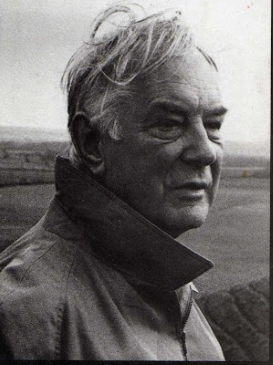
Geoffrey Edward Harvey Grigson was a British poet, writer, editor, critic, exhibition curator, anthologist and naturalist. In the 1930s he was editor of the influential magazine New Verse, and went on to produce 13 collections of his own poetry, as well as compiling numerous anthologies, among many published works on subjects including art, travel and the countryside. Grigson exhibited in the London International Surrealist Exhibition at New Burlington Galleries in 1936, and in 1946 co-founded the Institute of Contemporary Arts. Grigson's autobiography The Crest on the Silver was published in 1950. At various times he was involved in teaching, journalism and broadcasting. Fiercely combative, he made many literary enemies.

The Battle of Gazala was fought during the Western Desert Campaign of the Second World War, west of the port of Tobruk in Libya, from 26 May to 21 June 1942. Axis troops of the Panzerarmee Afrika consisting of German and Italian units fought the British Eighth Army composed mainly of British Commonwealth, Indian and Free French troops.
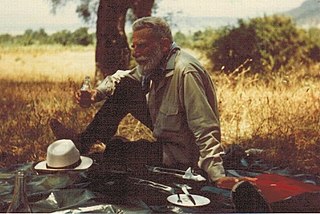
Theodore Philip Stephanides was a Greek-British doctor and polymath, best remembered as the friend and mentor of Gerald Durrell. He was also known as a naturalist, biologist, astronomer, poet, writer and translator.

Lieutenant-General Herbert William Lumsden, was a senior British Army officer who fought in both the First and Second World Wars. He commanded the 1st Armoured Division in the Western Desert campaign, and later commanded X Corps at the Second Battle of El Alamein, before being relieved by his superior, Lieutenant General Bernard Montgomery. He was killed in action by the Japanese in early 1945, becoming the most senior combat casualty of the British Army of the Second World War.

Number 92 Squadron, also known as No. 92 Squadron and currently as No. 92 Tactics and Training Squadron, of the Royal Air Force is a test and evaluation squadron based at RAF Waddington, Lincolnshire. It was formed as part of the Royal Flying Corps at London Colney as a fighter squadron on 1 September 1917. It deployed to France in July 1918 and saw action for just four months, until the end of the war. During the conflict it flew both air superiority and direct ground support missions. It was disbanded at Eil on 7 August 1919. Reformed on 10 October 1939,at Tangmere Airfield, the unit was supposed to be equipped with medium bombers but in the spring of 1940 it became one of the first RAF units to receive the Supermarine Spitfire, going on to fight in the Battle of Britain.

The 8th Armoured Brigade was an armoured brigade of the British Army formed in August 1941, during the Second World War and active until 1956. The brigade was formed by the renaming of 6th Cavalry Brigade, when the 1st Cavalry Division based in Palestine converted from a motorised formation to an armoured unit, becoming 10th Armoured Division.

The Eighth Army was a field army of the British Army during the Second World War. It was formed as the Western Army on 10 September 1941, in Egypt, before being renamed the Army of the Nile and then the Eighth Army on 26 September. It was created to better control the growing Allied forces based in Egypt and to direct their efforts to lift the siege of Tobruk via Operation Crusader.
The 22nd Battalion, also known as the "Wellington Battalion", was an infantry battalion of the New Zealand Military Forces, which served during the Second World War. After undertaking defensive duties in the United Kingdom from mid-1940 until early 1941, the battalion then fought in the Battles of Greece and Crete where it suffered heavy casualties and lost a large number of men who were taken as prisoners of war. After being rebuilt, the battalion fought in North Africa, fighting in Operation Crusader, before undertaking garrison duties in Syria. It later fought in the First Battle of El Alamein during which they suffered heavy casualties at Ruweisat Ridge. Re-formed, the battalion later fought in the Second Battle of El Alamein. In late 1943, the battalion was transferred to Italy where it fought for the remainder of the war, fighting battles around Cassino and along the Adriatic coast, before entering Trieste in the final days of the war. After the war, it performed occupation duties in Japan until it was disbanded in 1948.

The British Middle East Command Camouflage Directorate organised major deception operations for Middle East Command in the Western Desert Campaign of the Second World War. It provided camouflage during the siege of Tobruk; a dummy railhead at Misheifa, and the largest of all, Operation Bertram, the army-scale deception for the decisive battle of El Alamein in October 1942. The successful deception was praised publicly by Winston Churchill.

James Holland is an English popular historian, author and broadcaster, who specialises in the history of the Second World War.
John Clive Hall was an English poet and editor.

